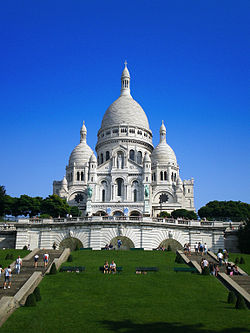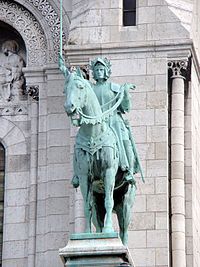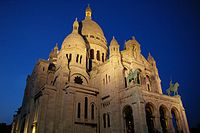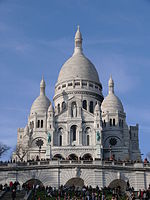- Basilique du Sacré-Cœur, Paris
-
For other Basilicas of the same name, see Basilica of the Sacred Heart (disambiguation).
Basilica of the Sacred Heart of Jesus of Paris
Basilique du Sacré-Cœur (French)
The Basilica of Sacré-Cœur, as seen from the base of the butte Montmartre.
Basic information Location Paris, France Geographic coordinates 48°53′12.1″N 2°20′34.8″E / 48.886694°N 2.343°ECoordinates: 48°53′12.1″N 2°20′34.8″E / 48.886694°N 2.343°E Affiliation Roman Catholic Year consecrated 1919 Ecclesiastical or organizational status Minor basilica Website Basilica of the Sacré Cœur Architectural description Architect(s) Paul Abadie Architectural type Church Architectural style Romano-Byzantine Groundbreaking 1875 Completed 1914 Specifications Length 35 metres (115 ft) Width 85 metres (279 ft) Height (max) 83 metres (272 ft) Materials Travertine stone The Basilica of the Sacred Heart of Paris, commonly known as Sacré-Cœur Basilica (French: Basilique du Sacré-Cœur, pronounced [sakʁe kœʁ]), is a Roman Catholic church and minor basilica, dedicated to the Sacred Heart of Jesus, in Paris, France. A popular landmark, the basilica is located at the summit of the butte Montmartre, the highest point in the city. Sacré-Cœur is a double monument, political and cultural, both a national penance for the supposed excesses of the Second Empire and socialist Paris Commune of 1871[1] crowning its most rebellious neighborhood, and an embodiment of conservative moral order, publicly dedicated to the Sacred Heart of Jesus, which was an increasingly popular vision of a loving and sympathetic Christ.[2]
The Sacré-Cœur Basilica was designed by Paul Abadie. Construction began in 1875 and was finished in 1914. It was consecrated after the end of World War I in 1919.
Contents
Basilique du Sacré Cœur
The inspiration for Sacré Cœur's design originated in the wake of the division in French society that arose in the decades following French Revolution, between devout Catholics and legitimist royalists on one side,[3] and democrats, secularists, socialists and radicals on the other. This schism became particularly pronounced after the Franco-Prussian War and the ensuing uprising of the Paris Commune of 1870-71. Though today the Basilica is asserted[4][when?] to be dedicated in honor of the 58,000 who lost their lives during the war, the decree of the Assemblée nationale, 24 January 2010, responding to a request by the archbishop of Paris by voting its construction, specifies that it is to "expiate the crimes of the Commune".[5] Montmartre had been the site of the Commune's first insurrection, and many dedicated communards were forever entombed in the subterranean galleries of former gypsum mines where they had retreated, by explosives detonated at the entrances by the Army of Versailles. Hostages had been executed on both sides, and the Communards had executed Georges Darboy, Archbishop of Paris, who became a martyr for the resurgent Catholic Church. His successor Guibert, climbing the Butte Montmartre in October 1872, was reported to have had a vision, as clouds dispersed over the panorama: "It is here, it is here where the martyrs are,[6] it is here that the Sacred Heart must reign so that it can beckon all to come".[7]
In the moment of inertia following the resignation of the government of Adolphe Thiers, 24 May 1873, François Pie, bishop of Poitiers, expressed the national yearning for spiritual renewal— "the hour of the Church has come"—[8] that would be expressed through the "Government of Moral Order" of the Third Republic, which linked Catholic institutions with secular ones, in "a project of religious and national renewal, the main features of which were the restoration of monarchy and the defense of Rome within a cultural framework of official piety",[9] of which Sacré-Cœur is the chief lasting triumphalist[10] monument.
The decree voting its construction as a "matter of public utility", 24 July,[11] followed close on Thiers' resignation. The project was expressed by the Church as a National Vow (Voeu national) and financial support came from parishes throughout France. The dedicatory inscription records the Basilica as the accomplishment of a vow by Alexandre Legentil and Hubert Rohault de Fleury, ratified by Joseph-Hippolyte Guibert, Archbishop of Paris. The project took many years to complete.
Construction
A law of public utility was passed to seize land at the summit of Montmartre for the construction of the basilica. Architect Paul Abadie designed the basilica after winning a competition over 77 other architects.[12] With delays in assembling the property, the foundation stone was finally laid 16 June 1875. Passionate debates concerning the Basilica were raised in the Conseil Municipal in 1880, where the Basilica was called "an incessant provocation to civil war" and it was debated whether to rescind the law of 1873 granting property rights, an impracticable proposition. The matter reached the Chamber of Deputies in the summer of 1882, in which the Basilica was defended by Archbishop Guibert while Georges Clemenceau argued that it sought to stigmatise the Revolution. The law was rescinded, but the Basilica was saved by a technicality and the bill was not reintroduced in the next session. A further attempt to halt the construction was defeated in 1897, by which time the interior was substantially complete and had been open for services for six years.[13]
 Equestrian Statue of Joan of Arc at Basilique du Sacré-Cœur
Equestrian Statue of Joan of Arc at Basilique du Sacré-Cœur
The overall style of the structure shows a free interpretation of Romano-Byzantine features, an unusual architectural vocabulary at the time, which was a conscious reaction against the neo-Baroque excesses of the Opéra Garnier, which was cited in the competition.[14] Many design elements of the basilica symbolise nationalist themes: the portico, with its three arches, is adorned by two equestrian statues of French national saints Joan of Arc (1927) and King Saint Louis IX, both executed in bronze by Hippolyte Lefebvre; and the nineteen-ton Savoyarde bell (one of the world's heaviest), cast in 1895 in Annecy, alludes to the annexation of Savoy in 1860.
Abadie died not long after the foundation had been laid, in 1884, and five architects continued with the work: Honoré Daumet (1884–1886), Jean-Charles Laisné (1886–1891), Henri-Pierre-Marie Rauline (1891–1904), Lucien Magne (1904–1916), and Jean-Louis Hulot (1916–1924). The Basilica was not completed until 1914, when war intervened; the basilica was formally dedicated in 1919, after World War I, when its national symbolism had shifted
Construction costs, estimated at 7 million French francs and drawn entirely from private donations, were expended before any above-ground visible structure was to be seen. A provisional chapel was consecrated 3 March 1876, and pilgrimage donations quickly became the mainstay of funding.[15] Donations were encouraged by the expedient of permitting donors to "purchase" individual columns or other features as small as a brick.[16] It was declared by the National Assembly that the state had the ultimate responsibility for funding.
Muted echoes of the Basilica's "tortured history" are still heard, geographer David Harvey has noted.[17] In February 1971 demonstrators pursued by the police took refuge in the Basilica and called upon their radical comrades to join them in occupying a church "built upon the bodies of communards in order to efface that red flag that had for too long floated over Paris" as their leaflets expressed it.
The Basilica
Sacré-Cœur is built of travertine stone quarried in Château-Landon (Seine-et-Marne), France. This stone constantly exudes calcite, which ensures that the basilica remains white even with weathering and pollution.
A mosaic in the apse, entitled Christ in Majesty, is among the largest in the world.
The basilica complex includes a garden for meditation, with a fountain. The top of the dome is open to tourists and affords a spectacular panoramic view of the city of Paris, which is mostly to the south of the basilica.
The use of cameras and video recorders is forbidden inside the Basilica.
The organ
The basilica is home to a large and very fine pipe organ built by Aristide Cavaillé-Coll for a private home in Biarritz, composed of 109 ranks and 78 speaking stops spread across four 61-note manuals and the 32-note pedalboard (unusual before the turn of the century; the standard of the day was 56 and 30), spread across three expressive divisions (also unusual for the time, even in large organs); the organ was ahead of its time, containing multiple expressive divisions and giving the performer considerable advantages over other even larger instruments of the day. It was almost identical (tonal characteristics, layout and casework) to the instrument in Sheffield's Albert Hall, destroyed by fire in 1934. However, when installed in Paris in 1905 by Cavaillé-Coll's successor and son-in-law, Charles Mutin, it lost its fine case for a much plainer one.[18]
Role in Catholicism
In response to requests from French bishops, Pope Pius IX promulgated the feast of the Sacred Heart in 1856. The basilica itself was consecrated on 16 October 1919.
Since 1885 (before construction had been completed), the Blessed Sacrament (a consecrated host which has been turned into the Body and Blood of Jesus Christ during Mass) has been continually on display in a monstrance above the high altar. Perpetual adoration of the Blessed Sacrament has continued uninterrupted in the Basilica since 1885. Because of this, tourists and others are asked to dress appropriately when visiting the basilica and to observe silence as much as possible, so as not to disturb persons who have come from around the world to pray in this special place.
Notes
- ^ An amendement that would have specified that the undertaking "was not solely a protestation of the taking up of arms by the Commune, but a sign of appeasement and concord" was rejected. (David Harvey, "Monument and Myth" Annals of the Association of American Geographers 69.3 (September 1979, pp. 362–381) p 377).
- ^ Raymond Anthony Jonas, France and the cult of the Sacred Heart: an epic tale for modern times, (University of California) 2000, ch. "Building the Church of the National Vow".
- ^ Marguerite Marie Alacoque, the evangelist for veneration of the Sacred Heart, was beatified by Pope Pius IX in 1864.
- ^ http://www.france-hotel-guide.com/en/basilique-du-sacre-coeur.htm
- ^ http://www.assemblee-nationale.fr/13/rap-info/i1262.asp
- ^ General Lecomte and General Clement Thomas, shot by insurrectionists in the early days of the Commune, in the garden of 6, rue des Rosiers. (Harvey "Monument and Myth" 1979, P 370).
- ^ Reported in the history of the construction to 1890, written from a dedicated Catholic perspective, by R. P. Jonquet, Montmartre Autrefois et Aujourd’hui (Paris: Dumoulin) 1890; quoted by Harvey "Monument and Myth" 1979, P364 .
- ^ Louis Baunard, Histoire du cardinal Pie 1886, vol. II:498, quoted in Raymond A. Jonas, "Monument as Ex-Voto, Monument as Historiosophy: The Basilica of Sacre-Coeur" French Historical Studies 18.2 (Autumn 1993, pp. 482–502) p. 483.
- ^ Jonas 1993:485
- ^ "The reaction to the communes of Paris and Lyon were triumphalist monuments, the Sacré-Coeur of Montmartre and the basilica of Fourvière, dominating both cities. These buildings were erected using private funds, as gigantic ex-votos, thanking God for the victory over the socialists and in expiation of the sins of modern France." (Bertrand Taithe, Citizenship and Wars: France in Turmoil, 1870–1871, chapter "Religious Identities and Citizenship" 2001:100).
- ^ According to its minutes; 23 July according to the dedicatory inscription in the Basilica.
- ^ The competition was commemorated in Souvenir du Concours de l’Église du Sacré-Cœur (Paris: J. Le Clere) 1874.
- ^ Harvey "Monument and Myth" 1979, pp 380–81 .
- ^ Legentil had wanted to demolish the half-built opera house and build triumphantly on the site of that "scandalous monument of extravagance, indecency and bad taste" (Harvey "Monument and Myth" 1979, P376 ).
- ^ In 1877, its first full year of operation, visiting pilgrims dropped over 240,000 francs into the collection boxes; the figure doubled the following year. (Jonas 1993:495).
- ^ This fund-raising technique, originated at Sacré-Cœur, became standard practice for funding cultural institutions' building projects in Europe and the Americas after World War I.
- ^ Harvey "Monument and Myth" 1979, P381 .
- ^ (http://www.uquebec.ca/musique/orgues/france/scoeurp.html)
External links
- Official site of Basilique du Sacré-Cœur, Paris
- Northwestern University Library: Briefings, Fall 2005: Scott Krafft, "Sacré Coeur on Montmartre"
- Official site of Montmartre
- Panoramic view
- Virtual tour 360 degrees in fullscreen Use the mouse to turn around
- Photo from a terrace in Paris
- le sacré coeur
Further reading
- Jacques Benoist, Le Sacre-Coeur de Montmartre de 1870 a nos Jours (Paris) 1992. A cultural history from the point-of-view of a former chaplain.
- Yvan Crist, "Sacré-Coeur" in Larousse Dictionnaire de Paris (Paris) 1964.
- David Harvey. Consciousness and the Urban Experience: Studies in the History and Theory of Capitalist Urbanization. (Baltimore: The Johns Hopkins University Press) 1985.
- David Harvey."The building of the Basilica of Sacré-Coeur", coda to Paris, Capital of Modernity (2003:311ff) Harvey made use of Hubert Rohault de Fleury. Historique de la Basilique du Sacré Coeur (1903–09), the official history of the building of the Basilica, in four volumes, printed, but not published.
- Raymond A. Jonas. “Sacred Tourism and Secular Pilgrimage: Montmartre and the Basilica of Sacré-Coeur”. in Montmartre and the Making of Mass Culture. Gabriel P. Weisberg, editor. (New Brunswick, NJ: Rutgers University Press) 2001.
Popular visitor attractions in Paris Arc de Triomphe • Sacré-Cœur • Cathedral of Notre Dame • Centre Georges Pompidou • Champs-Élysées • Conciergerie • Eiffel Tower • Grand Palais • Jardin du Luxembourg • Les Invalides • Louvre • Musée d'Orsay • Panthéon • Opéra Garnier • Père Lachaise Cemetery • Château de Vincennes • Sainte-Chapelle Categories:
Categories:- Visitor attractions in Paris
- Religious buildings completed in 1914
- 20th-century Roman Catholic church buildings
- Basilica churches in France
- Roman Catholic churches in the 18th arrondissement of Paris
- Landmarks in France
- Domes
- Montmartre
Wikimedia Foundation. 2010.




